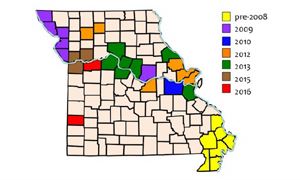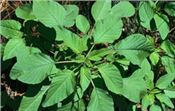Be On The Lookout For Palmer Amaranth During Harvest
COLUMBIA, MO.
Harvest is a good time to scout for potential 2017 weed problems, says University of Missouri Extension weed scientist Kevin Bradley.
Combines give a bird’s-eye view of problem spots. Most farmers make note of areas where weeds survived treatment.
Palmer amaranth continues to be the weed to watch in Missouri, Bradley says. This member of the pigweed family spread from the southwestern United States into the Midwest. It has moved north of the Missouri Bootheel area, where it is the predominant weed species in most fields.
Bradley has been tracking the spread of Palmer amaranth in Missouri since 2009. In 2016, Missouri fields showed some of the best weed control Bradley and other MU agronomists have seen, he says. Despite that, Palmer amaranth’s competitive and aggressive nature makes it a bigger threat than waterhemp, the most common pigweed species in the state.
It is fairly easy to distinguish Palmer amaranth from other pigweeds, Bradley says. Palmer amaranth is much wider and distinguishes itself by its diamond-shaped leaves. When viewed from above, the leaves of Palmer amaranth have a poinsettia-like arrangement. Mature seed heads have spiny, prickly bracts that extend beyond all other flower parts.
Mature Palmer amaranth often grows to more than 7 feet in height and usually produces about 500,000 seeds per plant. It resists glyphosate, the most-used weed control method in Missouri.
It is highly mobile. Palmer amaranth may have made its way into Missouri through contaminated farm equipment from other states. Contaminated hay also acts as a carrier. Bradley’s research has shown that waterfowl carry seeds for long distances and drop them in fields. Some states report Palmer amaranth coming in through seeds used for Conservation Reserve Program plantings and in pollinator mixes.
“In short, any seed, feed or equipment coming onto your farm should be thoroughly examined for the presence or even the possibility of Palmer amaranth seed,” Bradley says.
If possible, and if only a few plants are present, stop and rogue out Palmer amaranth plants that you see while combining, he says.
Bradley recommends the MU Weed ID app to identify the weed (weedID.missouri.edu). Samples also may be sent to MU’s Plant Diagnostic Clinic (plantclinic.missouri.edu).
Bradley will speak at the Dec. 15-16 Crop Management Conference in Columbia. Go to extension.missouri.edu/n/2923 for more information. ∆

